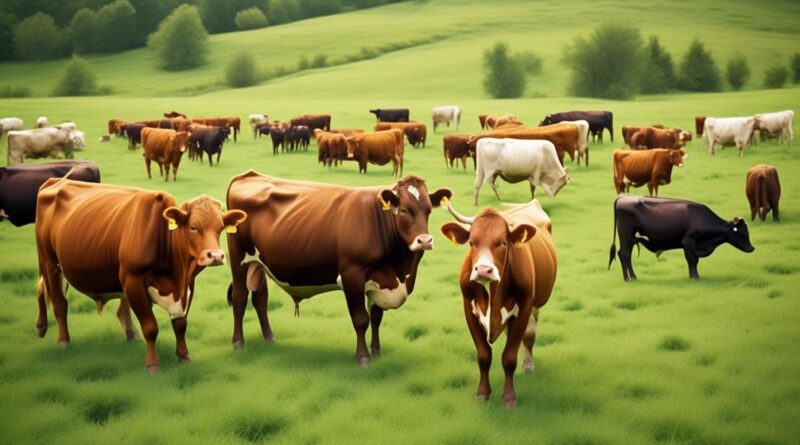Achieving Sustainable Cattle Management in Agriculture: A Holistic Guide
Imagine if you will, a well-tended garden. Just as the gardener carefully tends to the soil, ensuring it is nourished and maintained, sustainable cattle management in agriculture requires a similarly holistic approach.
The health and vitality of cattle and the land they graze upon are deeply intertwined, and achieving sustainable cattle management is essential for the long-term success of agricultural operations.
As you explore the principles and practices outlined in this guide, you'll gain valuable insights into the interconnectedness of cattle management and land stewardship, ultimately leading to more resilient and prosperous farming endeavors.
Importance of Sustainable Cattle Management
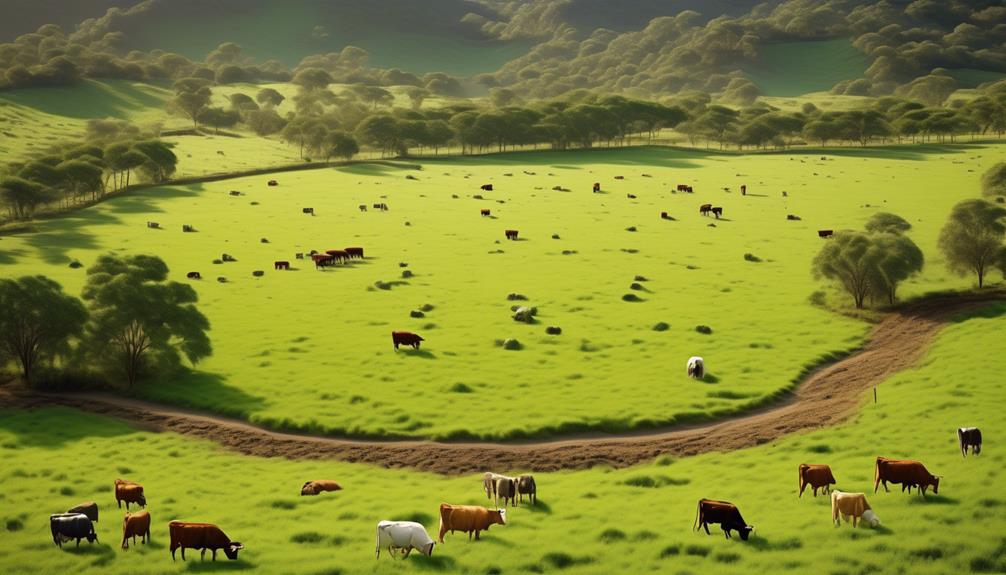
To effectively manage cattle sustainably, it's essential to prioritize their well-being and the long-term health of the environment. Sustainable cattle management is crucial for minimizing the environmental impact of cattle farming while maximizing the economic benefits. By implementing sustainable practices, such as rotational grazing and proper waste management, you can significantly reduce the negative environmental impact of cattle farming. This not only helps to preserve natural resources and biodiversity but also ensures the long-term viability of the land for future generations.
Furthermore, sustainable cattle management can lead to significant economic benefits. For instance, implementing rotational grazing not only improves the health of pastures but also reduces the need for costly supplemental feed. Additionally, proper waste management practices can generate valuable resources such as compost and biogas, providing alternative sources of income for farmers. By prioritizing sustainable cattle management, you can create a more efficient and cost-effective operation while also minimizing the overall environmental impact.
Understanding Cattle Behavior and Needs
Understanding the behavior and needs of cattle is crucial for effective and sustainable cattle management in agriculture. By gaining insight into their natural instincts and requirements, you can create an environment that promotes cattle welfare and supports their grazing behavior.
Here are four essential aspects to consider:
- Social Structure: Cattle are social animals with a hierarchical social structure. Understanding this dynamic is crucial for managing their interactions within the herd. Providing sufficient space and resources can help minimize aggression and promote harmonious coexistence.
- Grazing Patterns: Cattle have distinct grazing patterns influenced by factors such as vegetation type, weather, and time of day. Recognizing these patterns can aid in optimizing grazing land usage and implementing rotational grazing practices to prevent overgrazing and land degradation.
- Comfort and Shelter: Cattle welfare is closely tied to their physical comfort. Adequate shelter, access to shade, and comfortable resting areas are essential for ensuring their well-being, especially in extreme weather conditions.
- Behavioral Indicators: Observing behavioral indicators such as feeding habits, movement patterns, and vocalizations can provide valuable insights into the overall health and contentment of the herd. This understanding enables early detection of potential issues and allows for timely intervention.
Implementing Rotational Grazing Techniques
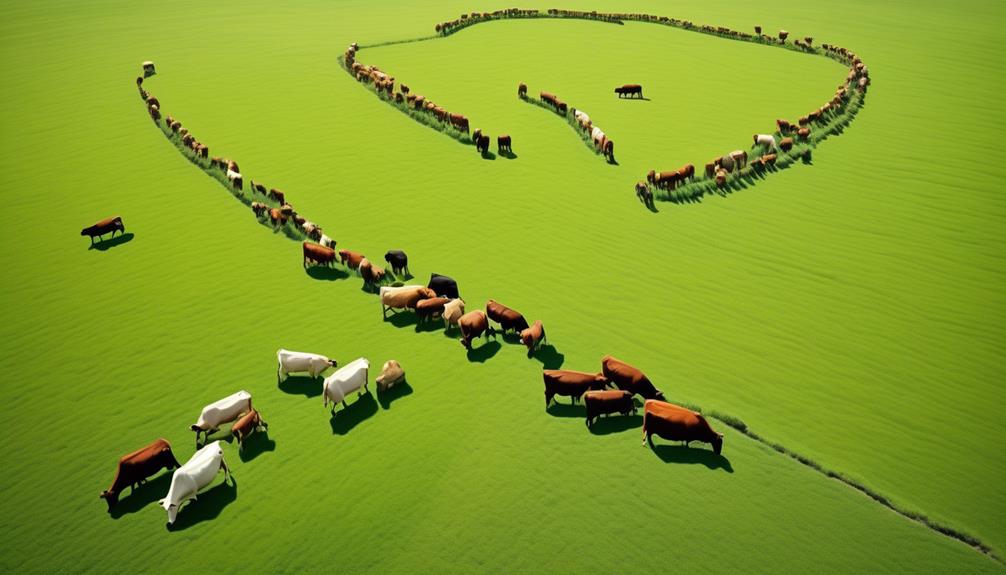
Gaining insight into the behavior and needs of cattle allows for the effective implementation of rotational grazing techniques, optimizing land usage and supporting cattle welfare in agriculture.
Rotational grazing involves dividing pastures into smaller sections, and moving livestock between these sections at regular intervals. This technique promotes grassland conservation and soil fertility by allowing pastures to recover and minimizing overgrazing.
By strategically rotating cattle to different areas, you can prevent the depletion of grass and ensure that the remaining vegetation has enough time to regrow. This not only benefits the health of the land but also provides cattle with a continuous supply of fresh, nutrient-rich forage. As a result, the overall soil fertility is improved, leading to healthier pastures and better-quality feed for the cattle.
Implementing rotational grazing techniques requires careful planning and monitoring of livestock movement. By dividing the grazing area into smaller paddocks, you can control where the cattle graze, and provide adequate time for pasture recovery. This approach not only maximizes the efficient use of available land but also prevents soil erosion and promotes the health of the entire ecosystem.
Utilizing Regenerative Grazing Practices
You can enhance soil health and promote biodiversity by implementing regenerative grazing practices in your cattle management strategies. Regenerative grazing benefits both your herd and the land by mimicking natural grazing patterns and allowing for ample recovery time for pastures. By integrating these grazing management techniques, you can make a positive impact on the environment while maintaining a thriving cattle operation.
To make the most of regenerative grazing practices, consider the following techniques:
- Rotational Grazing: Divide your grazing area into smaller paddocks and rotate your cattle through them regularly. This helps prevent overgrazing, allows for even distribution of manure, and promotes healthy regrowth of forage.
- Mob Grazing: Concentrate a larger number of cattle in a smaller area for a short period. This intense grazing followed by adequate rest periods can stimulate grass growth, build soil fertility, and reduce the need for supplemental feed.
- Managed Intensive Grazing: Utilize high stocking densities for short durations, followed by long recovery periods. This method encourages deep root growth, carbon sequestration, and enhanced water infiltration.
- Multi-Species Grazing: Introduce different types of livestock, such as sheep or goats, to graze alongside your cattle. This can help control weeds, reduce parasite loads, and diversify the impact on the land.
Managing Cattle Health and Nutrition
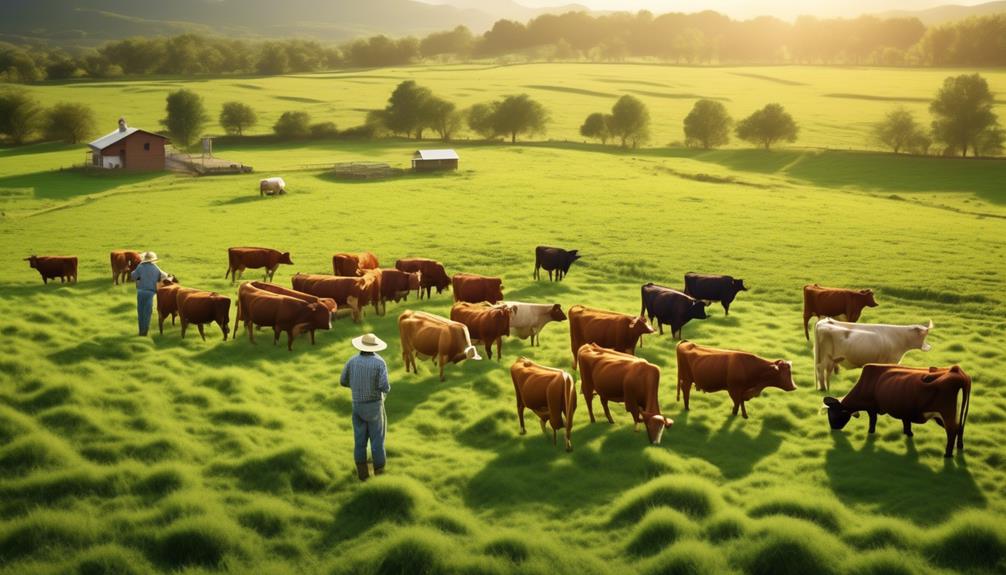
By prioritizing the health and nutrition of your cattle, you can further support the regenerative grazing practices previously discussed, ensuring the overall well-being of your herd and the sustainability of your agricultural operations.
Cattle feeding is a critical aspect of managing their health and nutrition. Providing a well-balanced diet that meets their nutritional needs is essential for their overall health and productivity. Ensure that your cattle have access to high-quality forage, supplemented with minerals and, if necessary, protein-rich feeds. Regularly assess the quality of your pastures and forage to make informed decisions about supplementation and grazing management.
In addition to proper feeding, veterinary care is crucial for maintaining the health of your cattle. Establish a good relationship with a veterinarian who can provide guidance on vaccination schedules, parasite control, and overall herd health management. Regular check-ups and prompt attention to any signs of illness or distress are vital in maintaining a healthy herd. Monitoring the body condition score of your cattle, along with observing their behavior and overall appearance, can help in identifying any health issues early on.
Remember that proactive management of cattle health and nutrition not only ensures the welfare of your animals but also contributes to the sustainability of your agricultural enterprise. By meeting their dietary needs and providing timely veterinary care, you're safeguarding the productivity and resilience of your herd, ultimately supporting the long-term success of your cattle management practices.
Integrating Cattle Into Crop Rotation Systems
Integrating cattle into crop rotation systems enhances soil fertility and promotes sustainable agricultural practices. By implementing this approach, you can enjoy several benefits:
- Enhanced Soil Fertility:
- Cattle grazing helps in the natural fertilization of the soil.
- Their manure provides essential nutrients, such as nitrogen and phosphorus, which are beneficial for crop growth.
- The trampling action of cattle can help in incorporating organic matter into the soil, improving its structure and nutrient-holding capacity.
- Weed Control:
- Cattle grazing can aid in controlling weed growth.
- Their feeding behavior can help manage weed populations by reducing their density and preventing them from competing with crops for essential resources like water and nutrients.
- Diversified Crop Production:
- Integrating cattle into crop rotation systems allows for diversified crop production.
- Cattle can graze on pasture lands during fallow periods, providing an additional source of income.
- This also allows the soil to recover and build up nutrients for the next crop cycle.
- Reduced Reliance on Chemical Inputs:
- The integration of cattle into crop rotation systems can potentially reduce the reliance on chemical fertilizers and pesticides.
- This contributes to a more sustainable and environmentally friendly approach to agriculture.
Enhancing Soil Health With Cattle Grazing
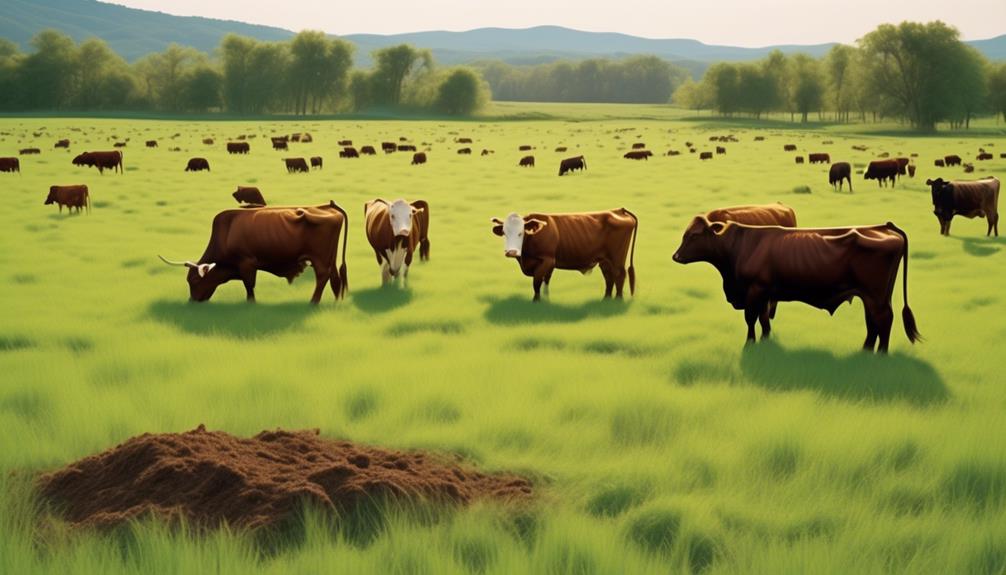
Enhancing soil health through cattle grazing involves incorporating natural fertilization, weed control, and diversified crop production into sustainable agricultural practices.
Cattle grazing can significantly impact soil fertility by returning essential nutrients to the land through their manure. This natural fertilization enriches the soil, promoting the growth of healthy and nutrient-rich crops.
Pasture management is crucial for enhancing soil health with cattle grazing. Rotational grazing, for instance, allows cattle to graze in a specific area for a limited time before being moved to a different section. This practice prevents overgrazing in one area, giving the land an opportunity to recover and rejuvenate. As a result, the soil is less compacted, allowing for better water infiltration and root growth.
Furthermore, the trampling effect of cattle can help break up compacted soil and increase organic matter incorporation. This aids in improving soil structure and promoting aeration, crucial for the growth of beneficial soil organisms.
Incorporating cattle into diversified crop production systems also contributes to weed control. By grazing on pasture lands, cattle can naturally manage weed growth, reducing the need for chemical herbicides and promoting a more sustainable approach to weed management.
Monitoring and Evaluating Grazing Impacts
Monitoring and evaluating grazing impacts on soil health and crop production is essential for ensuring sustainable cattle management in agriculture. By implementing a robust monitoring and evaluation system, you can effectively assess the effects of grazing on the ecosystem and make informed decisions to maintain ecosystem resilience and maximize productivity.
To achieve this, consider the following steps:
- Grazing Intensity Assessment: Regularly monitor and assess the intensity and duration of grazing in specific areas. This will help you understand the impact of cattle on vegetation and soil compaction, allowing for adjustments to prevent overgrazing and degradation of pastureland.
- Soil Health Monitoring: Implement soil testing and monitoring programs to evaluate the impact of grazing on soil nutrient levels, compaction, and organic matter content. By understanding these impacts, you can implement soil improvement strategies to maintain soil fertility and health.
- Vegetation Analysis: Conduct regular vegetation assessments to determine the impact of grazing on plant species composition, diversity, and productivity. This information can guide grazing management decisions to prevent the depletion of preferred forage species and promote biodiversity.
- Ecosystem Resilience Evaluation: Assess the overall resilience of the ecosystem to grazing impacts, considering factors such as water infiltration, erosion control, and wildlife habitat. This evaluation will inform adaptive management strategies to enhance ecosystem resilience and sustainability in the face of grazing pressure.
Frequently Asked Questions
Can Sustainable Cattle Management Practices Also Benefit the Local Ecosystem and Wildlife?
Sustainable cattle management practices can benefit the local ecosystem by reducing soil erosion and water pollution. Wildlife conservation is also enhanced through habitat preservation, creating a healthier environment for diverse plant and animal species.
What Are Some Common Challenges or Obstacles Faced When Transitioning to Sustainable Cattle Management Practices?
Transitioning to sustainable cattle management poses challenges like adapting to new practices, securing resources, and changing mindsets. However, solutions exist, such as education, financial support, and collaboration. Overcoming obstacles leads to a healthier, more sustainable agricultural system.
How Can Sustainable Cattle Management Contribute to Reducing Greenhouse Gas Emissions and Combating Climate Change?
By implementing sustainable cattle management, you can reduce emissions and combat climate change. Through proper land restoration and soil health practices, this approach contributes to minimizing greenhouse gas emissions and mitigating the environmental impact.
Are There Any Potential Economic Benefits or Drawbacks to Implementing Sustainable Cattle Management Practices?
Implementing sustainable cattle management practices can bring potential economic benefits such as reduced input costs and improved market access. However, there may be initial investment drawbacks. It's important to weigh these against the positive environmental impact.
What Are Some Innovative Technologies or Tools That Can Assist in Monitoring and Improving Grazing Impacts on the Land?
There are innovative technologies and monitoring tools that can help you improve grazing impacts on the land. These tools can provide real-time data and insights, allowing for more sustainable land management practices and environmental conservation.
Conclusion
You've learned the key components of sustainable cattle management in agriculture.
By understanding cattle behavior, implementing rotational grazing, and integrating them into crop rotation systems, you can enhance soil health and overall farm productivity.
Managing cattle health and nutrition, and monitoring grazing impacts are also crucial.
By following these holistic practices, you can achieve sustainable cattle management and contribute to a more environmentally-friendly and efficient agricultural system.
